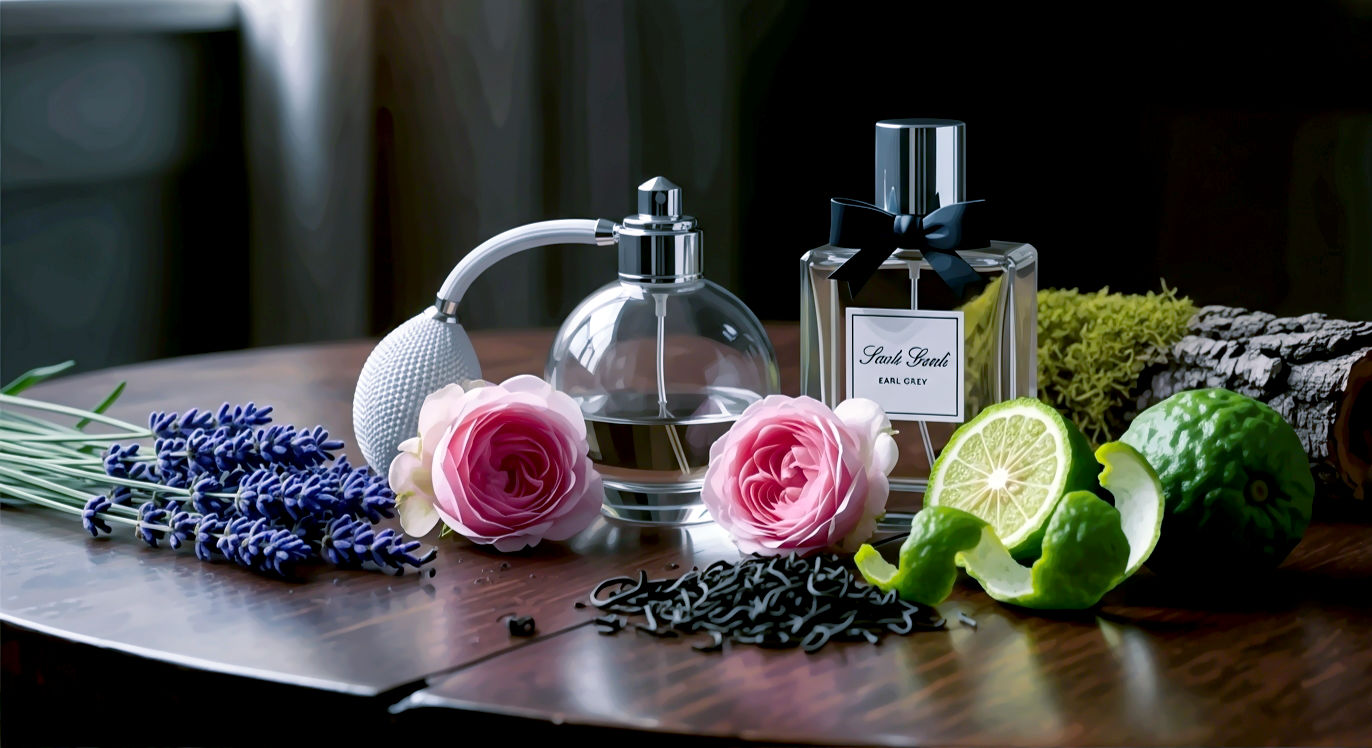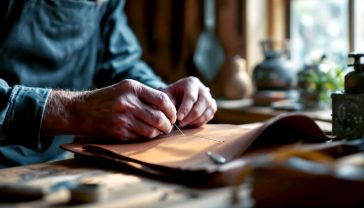British Perfumery: The Scent of Luxury and Heritage
Explore the definitive story of British perfume, from its royal origins to the innovative niche brands of today. This guide is your ultimate resource.

This post may contain affiliate links. If you make a purchase through these links, we may earn a commission at no additional cost to you.
Step into any grand British department store, and you’ll find them: gleaming bottles of perfume, each promising a little bit of magic. You might see names you know, like Penhaligon’s or Jo Malone London, their scents filling the air with hints of bluebells, English pear, or smoky Earl Grey tea. But have you ever stopped to think about the stories behind these smells? Where do they come from? And what makes a perfume truly ‘British’?
It turns out, the story of British perfume isn’t just about pretty bottles. It’s a fascinating tale that stretches back hundreds of years, involving kings and queens, daring explorers, clever inventors, and artists who paint pictures with scent. It’s a story about Britain’s relationship with the world, its love of gardens, and its quiet, confident sense of style.
Unlike the bold and glamorous perfumes of France or the rich, spicy scents of the Middle East, British perfumery has its own unique character. It’s often described as being more understated, more personal. Think of the smell of a damp forest floor after it rains, a freshly cut lawn on a summer’s day, or a cosy armchair next to a crackling fire. These are the scents that have inspired British perfume makers for generations. They capture a feeling, a memory, a little piece of the British soul.
In this guide, we’re going to unravel the secrets of British perfumery. We’ll travel back in time to the courts of Queen Elizabeth I, explore the London workshops where the first famous fragrances were born, and meet the modern-day creators who are shaking things up. We’ll look at the special ingredients that define British scents and discover how a perfume is actually made, from the first spark of an idea to the final spritz on your wrist. So, take a deep breath. Let’s dive into the scented world of British luxury and heritage.
The Dawn of British Scent: From Pomanders to Perfumers
Long before Chanel No. 5 or Dior’s J’adore, the story of scent in Britain wasn’t about glamour—it was about survival. In the 16th and 17th centuries, towns and cities were smelly, crowded places. Drains were open, rubbish was thrown in the streets, and personal hygiene wasn’t what it is today. People believed that bad smells, or ‘miasmas’, could carry diseases like the plague.
To protect themselves, wealthy Tudors and Stuarts carried pomanders. These were small metal balls, often beautifully decorated, filled with aromatic spices and herbs like cloves, cinnamon, ambergris, and musk. You’d hold it to your nose when walking through a smelly street, hoping the pleasant aroma would ward off illness. It was a personal air freshener and a status symbol all in one.
It was Queen Elizabeth I who truly brought fragrance into the realm of fashion. She had a famously sensitive nose and couldn’t stand bad smells. Her palaces were strewn with sweet-smelling herbs, and her ladies-in-waiting were expected to be fragrant. The Queen herself had her own perfumes made, and it’s said she even had a “still room” where she experimented with creating her own scents. This royal seal of approval made fragrance a must-have for anyone who was anyone in society.
The Rise of the London Perfumers
By the 18th century, London was a bustling hub of global trade. Ships arrived daily, their holds filled with exotic treasures from around the world: spices from India, resins from the Middle East, and flowers from the Mediterranean. This influx of new ingredients was like rocket fuel for the burgeoning perfume industry.
This was the era when the first great British perfume houses were born. These weren’t big, faceless companies. They were small, family-run businesses, often starting as barber shops or apothecaries.
One of the very first was Floris, which opened its doors at 89 Jermyn Street in London in 1730. Juan Famenias Floris, who came from Menorca, started by selling combs and razors but soon began creating bespoke fragrances for his distinguished customers. Floris quickly became a royal favourite, and it still holds a Royal Warrant from the Queen today. Stepping into their original shop is like stepping back in time.
Then came Yardley London in 1770. Famous for its lavender scents, Yardley captured the smell of the English countryside in a bottle. English lavender, with its clean, herbal, and slightly sweet aroma, became a signature note in British perfumery, loved for its calming and refreshing qualities.
But perhaps the most eccentric and theatrical of them all was William Penhaligon. A Cornish barber, he moved to London and, in the 1870s, became the Court Barber and Perfumer to Queen Victoria. His first scent, Hammam Bouquet, was inspired by the steamy, exotic smells of the Turkish Baths next to his shop. It was bold, unusual, and completely different from anything else at the time. Penhaligon’s set a new standard for creative, story-driven perfumery that continues to define the brand today.
These early pioneers weren’t just mixing smelly liquids together. They were crafting identities. Their scents were for the discerning gentleman and the elegant lady who appreciated quality, craftsmanship, and a touch of British eccentricity. They laid the foundations for a style of perfumery that was less about shouting for attention and more about a quiet, personal confidence.
What Makes a Perfume ‘British’? The Olfactory Signature
If you asked someone to describe a French perfume, they might say “glamorous,” “romantic,” or “chic.” An Italian perfume might be “loud,” “sunny,” and “passionate.” So, what about a British perfume? The words that often come to mind are “understated,” “elegant,” “natural,” and sometimes, a little bit “quirky.”
This isn’t just a marketing gimmick. There really is a distinct character to many British fragrances, shaped by the country’s history, culture, and landscape. It’s a style that whispers rather than shouts, favouring clarity and balance over overwhelming complexity.
The Pillars of the British Scent Profile
You can often spot a British perfume by the ingredients and moods it evokes. There are a few key themes that pop up time and time again.
1. The English Garden and Countryside
This is probably the most powerful influence. British perfumers are masters at capturing the scent of the natural world right on their doorstep. They bottle the experience of walking through a bluebell wood, tending a rose garden after a light shower, or picking blackberries from a hedgerow.
- Floral Notes: But not just any florals. British perfumery often leans towards the delicate, fresh scents of flowers like bluebell, lily-of-the-valley, hyacinth, and primrose. Of course, the rose is a national icon, but it’s often presented in a fresh, dewy, just-picked way, rather than a heavy, velvety oriental style.
- Green and Herbal Notes: Think of the smell of crushed leaves, damp moss, freshly cut grass, and ivy. There’s often a clean, almost “green” sharpness to British scents. Ingredients like mint, chamomile, and clary sage also play a big role, adding an aromatic, slightly medicinal quality that feels both refreshing and comforting.
- Fruity Notes: The fruits are typically those you’d find in an English orchard or a summer pudding. Pear, rhubarb, blackberry, and gooseberry add a tart, juicy sweetness that feels natural and not at all synthetic or sugary.
2. The Influence of Empire and Tea
Britain’s history as a global trading power brought a world of exotic scents to its shores. Spices, teas, and woods from far-flung corners of the empire were eagerly adopted and woven into the fabric of British life, and its perfumes.
- Tea: The ritual of afternoon tea is quintessentially British, and the scent of tea leaves is a recurring note. Earl Grey, with its distinctive bergamot aroma, is a classic. You’ll also find fragrances built around the smoky scent of Lapsang Souchong or the clean, green notes of white tea.
- Spices: Spices like cardamom, nutmeg, clove, and ginger add warmth and complexity. They might be used to evoke the cosy feeling of a spiced winter pudding or the sophisticated scent of a gentleman’s gin and tonic.
- Woods and Resins: Woods like cedarwood and sandalwood provide a solid, dependable backbone to many scents, reminiscent of old libraries, church pews, or antique furniture.
3. A Touch of Eccentricity
There’s a playful, quirky side to the British character that often finds its way into perfumery. This is the scent of the unconventional aristocrat, the creative artist, or the charmingly odd inventor.
These fragrances might feature an unexpected clash of notes, like pairing a classic floral with a sharp, metallic tang, or a smoky leather with a sweet, jammy fruit. They tell a story and don’t take themselves too seriously. Brands like Penhaligon’s and, more recently, Miller Harris excel at this, creating scents inspired by everything from London’s urban allotments to the pages of a dusty old novel.
This combination of the familiar (the garden) and the exotic (the trade routes), all filtered through a lens of refined elegance and a dash of wit, is what creates the unique olfactory signature of British perfumery. It’s a scent that feels both rooted in heritage and open to the world.
The Anatomy of a Fragrance: How Perfumes Are Made
Creating a perfume is a bit like composing a piece of music. Instead of musical notes, the perfumer, often called a “nose,” works with scent notes. They blend different ingredients together to create a harmonious chord, or “accord,” and then layer these accords to build a complete fragrance. It’s a delicate balance of art and science.
Every perfume has a structure, typically described as a pyramid with three levels: the top notes, the middle (or heart) notes, and the base notes. This structure determines how the scent unfolds on your skin over time.
The Olfactory Pyramid
Top Notes: The First Impression
When you first spray a perfume, the scents you smell immediately are the top notes. These are made of small, light molecules that evaporate quickly. They are designed to be bright, fresh, and attention-grabbing, creating the initial sparkle. They typically last for the first 5 to 15 minutes.
- Common Top Notes: Citrus fruits (like bergamot, lemon, grapefruit), light herbs (like lavender, mint), and airy green notes. In British perfumery, you’ll often find crisp notes like juniper berry (think gin!) or the tartness of rhubarb.
Middle Notes: The Heart of the Scent
Once the top notes have faded, the middle notes, or the heart of the fragrance, begin to emerge. These form the main character of the perfume. They are made of slightly heavier molecules and can last for several hours. The heart is where the perfumer tells the main story of the scent.
- Common Middle Notes: This is usually where the florals come in (rose, jasmine, lily), along with spices (cardamom, black pepper) and fruits (pear, blackberry). For a classic British scent, this might be a bouquet of English rose and bluebell, or perhaps the aromatic scent of Earl Grey tea.
Base Notes: The Lasting Memory
The base notes are the final part of the fragrance to appear. They are made of large, heavy molecules that evaporate very slowly. They provide depth and richness, and they are what you can still smell on your skin (or your jumper) hours later. The base notes act as an anchor for the whole composition, helping the lighter notes last longer.
- Common Base Notes: Woods (sandalwood, cedarwood, vetiver), resins (amber, frankincense), and musks are the stars here. A British perfume might have a base of oakmoss to evoke a damp forest floor, or a warm, comforting amber that feels like a cosy fireside.
From Raw Materials to Bottled Scent
So where do all these wonderful smells come from? Perfume ingredients can be sourced from the natural world or created in a laboratory.
- Natural Ingredients: These are extracts from plants, flowers, woods, and even, historically, animals.
- Flowers and Blossoms: Rose, jasmine, and orange blossom are classic examples. The scent is usually extracted through methods like distillation (steaming the plant material to release its essential oils) or solvent extraction (using a solvent to dissolve the aromatic compounds).
- Woods and Mosses: Sandalwood, cedarwood, and oakmoss provide earthy, grounding notes.
- Spices and Herbs: Cinnamon, clove, mint, and rosemary add warmth and aromatic freshness.
- Resins: Frankincense and myrrh are sticky saps from trees that have been used in incense and perfume for thousands of years.
- Animalics (Mostly Synthetic Today): In the past, ingredients like musk (from the musk deer) and ambergris (a substance from sperm whales) were highly prized for their rich, long-lasting scent. For ethical reasons, these are now almost always recreated synthetically.
- Synthetic Ingredients: Today, chemists can recreate the smell of natural ingredients in a lab. They can also invent entirely new smells that don’t exist in nature. Synthetics are crucial in modern perfumery. They offer consistency (a rose picked in May might smell different from one picked in June), protect endangered species (like the musk deer), and allow for incredible creativity.
The perfumer’s job is to take this vast palette of hundreds, if not thousands, of ingredients and blend them with precision and imagination. They might work on a single fragrance for months or even years, tweaking the formula one drop at a time until it perfectly captures the story they want to tell. It’s a slow, meticulous process that requires a deep understanding of chemistry and a true artist’s soul.
The Modern Renaissance: British Perfumery Today
For a long time, the world of perfume was dominated by the grand fashion houses of Paris. British perfumery, while respected, was seen as a bit traditional, a bit niche. But in the last couple of decades, something exciting has happened. A new wave of creative, independent, and distinctly British perfume brands has burst onto the scene, shaking things up and making London one of the most exciting fragrance capitals in the world.
This modern renaissance is all about individuality, storytelling, and a fresh take on what it means to be a British brand.
The Game-Changer: Jo Malone London
You can’t talk about modern British perfume without talking about Jo Malone London. When the brand launched in 1990, it did something radically different. Its fragrances were clean, simple, and focused on just one or two star ingredients, like Lime Basil & Mandarin or English Pear & Freesia. This was a world away from the complex, heavy perfumes that were popular at the time.
The brand’s philosophy was also revolutionary. They introduced the idea of “Fragrance Combining™”, encouraging customers to layer different scents to create their own unique signature. You could spray a little bit of the zesty Grapefruit over the warm Wood Sage & Sea Salt to make something entirely personal. This clever concept empowered people to be their own perfumers, and it was a huge hit.
Jo Malone London’s elegant, cream-and-black packaging and its focus on quintessentially British ingredients and inspirations (like a “Blackberry & Bay” cologne) helped to redefine modern British luxury. It made perfume feel accessible, personal, and fun.
The Rise of the Niche and Artisan Brands
Inspired by this new energy, a host of independent or “niche” brands have emerged, each with its own unique vision. These creators are less interested in following trends and more focused on crafting high-quality, interesting scents that tell a personal story.
- Miller Harris: Founded by Lyn Harris in 2000, this brand is like the cool, artistic cousin of the more traditional houses. Miller Harris finds inspiration in the unexpected corners of British life, from the urban grit of London’s markets to the quiet beauty of a windswept coastline. Scents like ‘Scherzo’ and ‘Tea Tonique’ are complex, modern, and full of character.
- Roja Parfums: At the highest end of luxury, you have Roja Dove. A true master perfumer, Dove creates opulent, incredibly complex fragrances using the rarest and most expensive ingredients in the world. Housed in Harrods’ famous “Salon de Parfums,” Roja Parfums is all about uncompromising quality and old-school glamour, reimagined for the 21st century.
- Ormonde Jayne: Linda Pilkington’s Ormonde Jayne is celebrated for its elegance and its use of unusual, exotic ingredients that you won’t find anywhere else, like hemlock and black truffle. The brand perfectly blends classic British refinement with a bold, international spirit.
- Floral Street: For a more contemporary and sustainable approach, look to Floral Street. Based in Covent Garden, this brand creates vibrant, vegan floral scents with names like ‘Wonderland Peony’ and ‘Electric Rhubarb’. Their eco-friendly packaging and accessible price point are designed to appeal to a younger, more environmentally-conscious audience.
These brands, and many others, are proving that British perfumery is more diverse and dynamic than ever before. They are honouring the traditions of quality and craftsmanship established by houses like Floris and Penhaligon’s, but they are pushing the boundaries, exploring new ingredients, and telling new stories that reflect the complex, multicultural Britain of today.
Finding Your Signature Scent: A Practical Guide
Choosing a perfume can feel overwhelming. With so many options, how do you find the one that feels like you? The secret is to have fun, trust your own nose, and take your time. Here are some practical tips to help you navigate the world of fragrance and find your perfect British scent.
1. Know Your Fragrance Families
Perfumes are generally grouped into “families” based on their dominant characteristics. Knowing which family you naturally gravitate towards can be a great starting point. The main ones are:
- Floral: The largest family, from single flower scents (soliflores) to complex bouquets. Can be fresh, powdery, or slightly spicy. Perfect for you if you love the smell of fresh flowers and romantic, feminine scents.
- Fresh: This family includes citrus, green, and aquatic (watery) notes. Think zesty lemons, crushed mint leaves, or the smell of the sea. Perfect for you if you like clean, crisp, and uplifting scents that aren’t too heavy.
- Oriental: Rich and sensual, this family is built around warm notes of amber, vanilla, spices, and resins. Perfect for you if you enjoy warm, spicy, and exotic scents with a touch of mystery.
- Woody: Centred on the aromas of woods and mosses, like sandalwood, cedarwood, vetiver, and oakmoss. These scents are often dry, smoky, and earthy. Perfect for you if you love the smell of nature, forests, and cosy, grounding aromas.
Many British perfumes fall into the Floral and Fresh categories, often with a Woody base. A scent like Jo Malone London’s ‘Wood Sage & Sea Salt’ is a great example of a Fresh/Woody fragrance, while Penhaligon’s ‘The Favourite’ is a beautiful powdery Floral.
2. How to Test Perfume Like a Pro
The single most important rule of perfume shopping is: always test on your skin. The scent you smell on a paper testing strip will be different from how it smells on you, because your unique body chemistry will interact with the perfume oils.
- Don’t Overload Your Senses: Your nose gets tired quickly. Try not to test more than three or four different scents at one time. Any more than that, and they’ll all start to blend together.
- Spray, Don’t Rub: When you test on your wrist, spritz from a few inches away and let it dry naturally. Don’t rub your wrists together! This crushes the delicate top notes and heats up the skin, which can change how the scent develops.
- Give it Time: Remember the olfactory pyramid? A perfume needs time to unfold. The scent you smell in the first minute will be very different from the scent an hour later. Spray it on, and then go for a walk. Have a coffee. See how the fragrance evolves and whether you still love it after the heart and base notes have revealed themselves.
- Ask for a Sample: If you’re unsure, don’t be afraid to ask for a small sample vial to take home. This allows you to live with the fragrance for a day or two and see how it feels in different environments before you commit to a full bottle.
3. Building a Scent Wardrobe
Just as you wouldn’t wear the same outfit to a business meeting and a summer picnic, you might not want to wear the same fragrance for every occasion. Many people enjoy building a “scent wardrobe” with a few different options to suit their mood or the season.
- A Daytime Scent: Something light, fresh, and energising is perfect for the office or casual wear. A citrus or light floral scent from a brand like Miller Harris or Floral Street would be ideal.
- An Evening Scent: For a special occasion, you might want something a bit richer and more complex. An Oriental or a deep Woody fragrance from Roja Parfums or Penhaligon’s could be the perfect choice.
- A Seasonal Scent: Many people like to switch their fragrance with the seasons. A crisp, green scent in the spring, a sunny floral in the summer, a warm, spicy scent in the autumn, and a cosy, woody amber in the winter.
Ultimately, there are no rules. The most important thing is to choose a fragrance that makes you feel happy, confident, and comfortable in your own skin. Your signature scent is the one that tells your story.
The Future of British Perfumery: Heritage Meets Innovation
The world of British perfume is in a very exciting place. It’s a world where centuries of heritage sit comfortably alongside cutting-edge innovation. So, what does the future hold for the scent of Britain?
One of the biggest trends shaping the industry is sustainability. Modern consumers, especially younger ones, want to know where the ingredients in their perfumes come from. They want brands to be transparent, ethical, and environmentally friendly.
- Ethical Sourcing: Brands are now putting a huge focus on sourcing their raw materials responsibly. This means working with farming communities around the world to ensure fair trade practices and to protect biodiversity. They are looking for ways to cultivate and harvest precious ingredients, like sandalwood or rose, without damaging the environment.
- Green Chemistry: In the lab, scientists are developing new “green” methods for creating synthetic molecules. This involves using renewable resources and creating biodegradable ingredients that don’t harm the planet. The goal is to make fragrances that are beautiful for you and kind to the earth.
- Eco-Friendly Packaging: The days of excessive plastic and cellophane are numbered. Brands like Floral Street are leading the way with recyclable and even compostable packaging. Refillable bottles are also becoming more common, reducing waste and allowing customers to keep their beautiful perfume bottles forever.
Another key trend is personalisation. In a world where everyone wants to express their unique identity, the idea of a one-size-fits-all perfume is becoming less appealing. The future is about bespoke and customisable fragrances.
- Scent Profiling: Many niche boutiques now offer “scent profiling” experiences. You’ll sit down with a fragrance expert who will ask you about your favourite smells, memories, and personality, and then guide you to a perfume that perfectly matches your profile.
- Bespoke Creation: For the ultimate luxury, some houses offer a fully bespoke service where a master perfumer will create a fragrance just for you. It’s a long and expensive process, but the result is a true one-of-a-kind signature scent.
- AI and Technology: Technology is also starting to play a role. Some companies are using AI algorithms to analyse customer preferences and suggest personalised fragrance combinations. Imagine an app that could design a scent for you based on your favourite music or holiday destinations.
What’s clear is that the future of British perfumery will be a blend of the old and the new. The stories, the craftsmanship, and the connection to the British landscape will always be at its heart. But these traditions will be enhanced by new technology, a deeper commitment to sustainability, and a creative spirit that is always looking for the next exciting story to tell in scent.
From a simple pomander designed to ward off bad smells to the complex, artistic creations of today, the journey of British perfumery is a reflection of the nation’s own story. It’s a story of quiet confidence, a love of nature, a respect for tradition, and a quirky, creative spark. So next time you spray your favourite fragrance, take a moment. You’re not just putting on a perfume; you’re wearing a little piece of British history.
Further Reading
For those interested in exploring the world of British perfumery further, these resources offer a wealth of information and are highly respected within the industry:
- The Perfume Society: A fantastic resource for fragrance lovers, offering news, reviews, and discovery boxes. https://perfumesociety.org/
- Basenotes: An extensive online database and community for perfume enthusiasts, with reviews and forums. https://www.basenotes.net/
- Fragrantica: A popular online encyclopedia of perfumes and a magazine for fragrance lovers. https://www.fragrantica.com/
- The websites of the heritage brands: Exploring the official sites of houses like Floris, Penhaligon’s, and Yardley London offers a direct glimpse into their rich histories.






